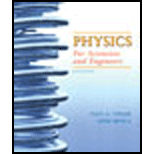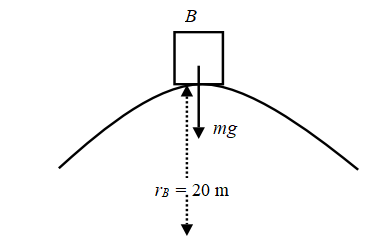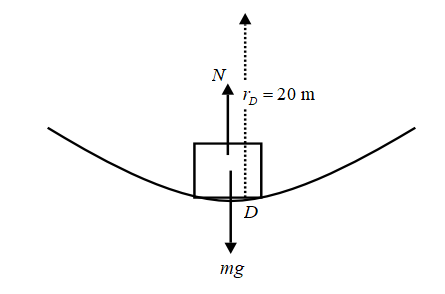
Concept explainers
(a)
The height of point B above the ground, if the car at A barely makes it up the hill at B.
(a)
Answer to Problem 97P
The point B is at a height of
Explanation of Solution
Given:
The mass of the roller- coaster carriage
Speed at point A
Height of A above the ground
Formula used:
The carriage at A has both potential and kinetic energies.
However, the carriage just manages to make it over the point B . This means that at B the carriage has no kinetic energy, it has potential energy alone by virtue of its position.
Therefore, the energy at B is given by,
Apply the law of conservation of energy to the motion of the carriage between points A and B .
Therefore,
Hence,
Calculation:
Substitute the values of the variables in equation (1).
Conclusion:
Thus, the point B is at a height of
(b)
The magnitude of the force exerted by the track on the car if it is just able to make it over the hill at B .
(b)
Answer to Problem 97P
Explanation of Solution
Given:
The mass of the roller- coaster carriage
Radius of curvature of the hill located at B .
Formula used:
The car crosses over a hill of radius of curvature
provides the centripetal force. This is shown in Figure 1, below:

Figure 1
Thus, the force exerted by the track on the car is the centripetal force and this is equal to the weight of the car.
Calculation:
Substitute the given values of the variables in equation (2).
Conclusion:
Thus, the magnitude of the force exerted by the track on the car at point B is found to be
(c)
The acceleration of the car at point C .
(c)
Answer to Problem 97P
Explanation of Solution
Given:
The angle of the incline
Formula used:
The point C is on an incline and when no dissipative forces act on the car, the car moves down with a constant acceleration. Modelling the motion of the car at point C as that over an incline, the free body diagram of the car is drawn.

Figure 2
The car is under the action of two forces: (i) the weight
Since the block is in equilibrium along the direction perpendicular to the incline,
However, the component
Hence,
Calculation:
Substitute the values of the variables in equation (3) and calculate the value of the acceleration at point C .
Conclusion:
Thus, the acceleration of the car at point C is found to be
(d)
The force exerted by the track on the car at point D .
(d)
Answer to Problem 97P
The force exerted by the track on the car at point D is found to be
Explanation of Solution
Given:
The mass of the roller- coaster carriage
Radius of curvature of the valley located at D .
Height of point B above the ground
Formula used:
The point D is located at the ground level. Assuming the car has zero velocity at B , its energy is entirely potential at B . This energy is converted into kinetic energy at D .
Using the law of conservation of energy
At D the car traces an arc of radius

Figure 3
The car is acted upon by two forces- (i) Its weight
The total inward force provides the centripetal force, which is given by the expression
Therefore,
Hence,
From equation (4),
Equation (5), therefore can be simplified as follows:
Therefore,
Calculation:
Substitute the values of the variables in equation (6).
Conclusion:
Thus, the force exerted by the track on the car at point D is found to be
(e)
The magnitude and the direction of the force exerted by the track at the point F which lies in the middle of a banked horizontal curve of radius 30 m.
(e)
Answer to Problem 97P
The magnitude of the force exerted by the track on the car is
Explanation of Solution
Given:
The mass of the roller- coaster carriage
Height of point F above the ground
Radius of curvature of the path at F
Speed at point A
Formula used:
The car is at the same height as point A . The system is under the action of gravitational forces alone. Hence the speed at F is equal to the speed at A .
The car is on a horizontal banked road. The forces acting on the car are shown in Figure 4.

Figure 4
The forces acting on the car are (i) weight
The normal force N is resolved into two components-
The car is in equilibrium along the y direction.
Therefore,
The component
The force exerted by the track on the car is given by,
The angle made by the force N with the horizontal is given by,
Calculation:
Substitute the values of the variables in equation (7) and calculate the value of
Substitute the values of the variables in equation (8) and calculate the value of
Substitute the values of the variables in equation (9) and calculate the magnitude of the force exerted by the track on the car.
Calculate the angle made by the force with the horizontal using equation (10).
Conclusion:
Thus, the magnitude of the force exerted by the track on the car is
(f)
The magnitude of the braking force that needs to be applied at G so that the car comes to rest in a distance of 25 m.
(f)
Answer to Problem 97P
The magnitude of the braking force that needs to be applied at G so that the car comes to rest in a distance of 25 m is
Explanation of Solution
Given:
The mass of the roller-coaster carriage
Speed at point A
Distance travelled before stopping
The final velocity of the car
Formula used:
The point G is at the same height as points F and A . Therefore, the speed at G is equal to the speed at A .
The acceleration of the car is determined using the expression,
The braking force can be determined using Newton’s second law:
Calculation:
Substitute the values of the variables in equation (11) and calculate the acceleration at G .
The negative sign shows that the acceleration is directed opposite to the car’s velocity.
Calculate the braking force using equation (12).
Conclusion:
Thus, the magnitude of the braking force that needs to be applied at G so that the car comes to rest in a distance of 25 m is
Want to see more full solutions like this?
Chapter 7 Solutions
Physics for Scientists and Engineers, Vol. 1
- simple diagram to illustrate the setup for each law- coulombs law and biot savart lawarrow_forwardA circular coil with 100 turns and a radius of 0.05 m is placed in a magnetic field that changes at auniform rate from 0.2 T to 0.8 T in 0.1 seconds. The plane of the coil is perpendicular to the field.• Calculate the induced electric field in the coil.• Calculate the current density in the coil given its conductivity σ.arrow_forwardAn L-C circuit has an inductance of 0.410 H and a capacitance of 0.250 nF . During the current oscillations, the maximum current in the inductor is 1.80 A . What is the maximum energy Emax stored in the capacitor at any time during the current oscillations? How many times per second does the capacitor contain the amount of energy found in part A? Please show all steps.arrow_forward
- A long, straight wire carries a current of 10 A along what we’ll define to the be x-axis. A square loopin the x-y plane with side length 0.1 m is placed near the wire such that its closest side is parallel tothe wire and 0.05 m away.• Calculate the magnetic flux through the loop using Ampere’s law.arrow_forwardDescribe the motion of a charged particle entering a uniform magnetic field at an angle to the fieldlines. Include a diagram showing the velocity vector, magnetic field lines, and the path of the particle.arrow_forwardDiscuss the differences between the Biot-Savart law and Coulomb’s law in terms of their applicationsand the physical quantities they describe.arrow_forward
- Explain why Ampere’s law can be used to find the magnetic field inside a solenoid but not outside.arrow_forward3. An Atwood machine consists of two masses, mA and m B, which are connected by an inelastic cord of negligible mass that passes over a pulley. If the pulley has radius RO and moment of inertia I about its axle, determine the acceleration of the masses mA and m B, and compare to the situation where the moment of inertia of the pulley is ignored. Ignore friction at the axle O. Use angular momentum and torque in this solutionarrow_forwardA 0.850-m-long metal bar is pulled to the right at a steady 5.0 m/s perpendicular to a uniform, 0.650-T magnetic field. The bar rides on parallel metal rails connected through a 25-Ω, resistor (Figure 1), so the apparatus makes a complete circuit. Ignore the resistance of the bar and the rails. Please explain how to find the direction of the induced current.arrow_forward
- For each of the actions depicted, determine the direction (right, left, or zero) of the current induced to flow through the resistor in the circuit containing the secondary coil. The coils are wrapped around a plastic core. Immediately after the switch is closed, as shown in the figure, (Figure 1) in which direction does the current flow through the resistor? If the switch is then opened, as shown in the figure, in which direction does the current flow through the resistor? I have the answers to the question, but would like to understand the logic behind the answers. Please show steps.arrow_forwardWhen violet light of wavelength 415 nm falls on a single slit, it creates a central diffraction peak that is 8.60 cm wide on a screen that is 2.80 m away. Part A How wide is the slit? ΟΙ ΑΣΦ ? D= 2.7.10-8 Submit Previous Answers Request Answer × Incorrect; Try Again; 8 attempts remaining marrow_forwardTwo complex values are z1=8 + 8i, z2=15 + 7 i. z1∗ and z2∗ are the complex conjugate values. Any complex value can be expessed in the form of a+bi=reiθ. Find θ for (z1-z∗2)/z1+z2∗. Find r and θ for (z1−z2∗)z1z2∗ Please show all stepsarrow_forward
 Principles of Physics: A Calculus-Based TextPhysicsISBN:9781133104261Author:Raymond A. Serway, John W. JewettPublisher:Cengage Learning
Principles of Physics: A Calculus-Based TextPhysicsISBN:9781133104261Author:Raymond A. Serway, John W. JewettPublisher:Cengage Learning University Physics Volume 1PhysicsISBN:9781938168277Author:William Moebs, Samuel J. Ling, Jeff SannyPublisher:OpenStax - Rice University
University Physics Volume 1PhysicsISBN:9781938168277Author:William Moebs, Samuel J. Ling, Jeff SannyPublisher:OpenStax - Rice University College PhysicsPhysicsISBN:9781285737027Author:Raymond A. Serway, Chris VuillePublisher:Cengage Learning
College PhysicsPhysicsISBN:9781285737027Author:Raymond A. Serway, Chris VuillePublisher:Cengage Learning Classical Dynamics of Particles and SystemsPhysicsISBN:9780534408961Author:Stephen T. Thornton, Jerry B. MarionPublisher:Cengage Learning
Classical Dynamics of Particles and SystemsPhysicsISBN:9780534408961Author:Stephen T. Thornton, Jerry B. MarionPublisher:Cengage Learning Glencoe Physics: Principles and Problems, Student...PhysicsISBN:9780078807213Author:Paul W. ZitzewitzPublisher:Glencoe/McGraw-Hill
Glencoe Physics: Principles and Problems, Student...PhysicsISBN:9780078807213Author:Paul W. ZitzewitzPublisher:Glencoe/McGraw-Hill Physics for Scientists and Engineers with Modern ...PhysicsISBN:9781337553292Author:Raymond A. Serway, John W. JewettPublisher:Cengage Learning
Physics for Scientists and Engineers with Modern ...PhysicsISBN:9781337553292Author:Raymond A. Serway, John W. JewettPublisher:Cengage Learning





